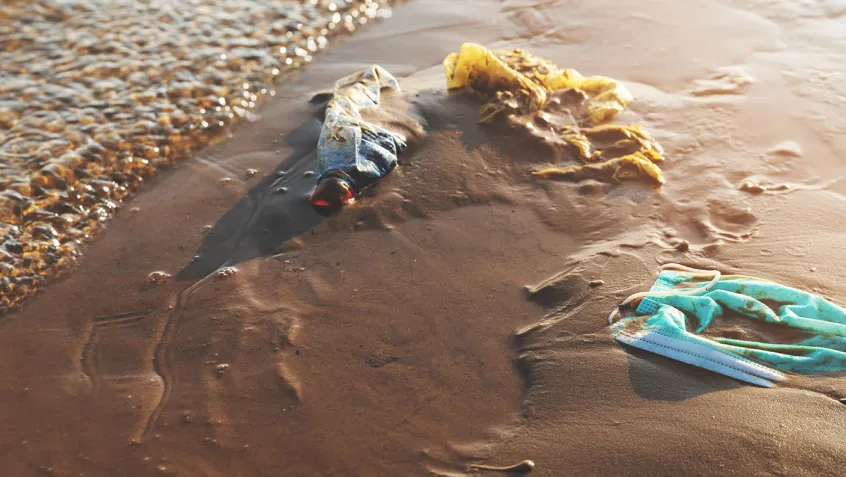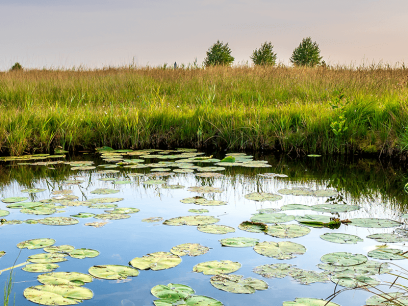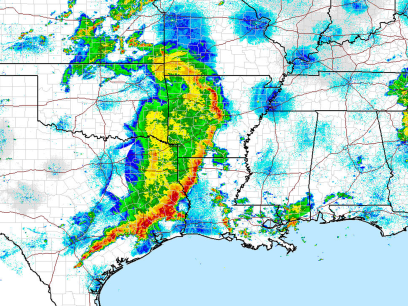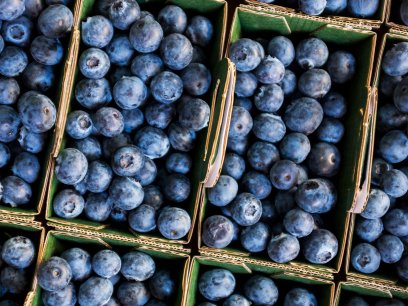
Fast Facts About Plastic Use During COVID-19 Pandemic
- COVID-19 shifted the tide back toward single-use plastics in healthcare, shopping, and food service.
- Globally, 3.4 billion single-use face masks and shields are used each day during the pandemic.
- A survey of consumers in 23 countries reported a 53% increase in their households' plastic packaging waste during the pandemic.
COVID-19’s Environmental Impact
Single-use utensils. Grocery bags. PPE. If you feel like you’re using more plastic than ever before during the COVID-19 pandemic, you’re not alone.
Early on, there was hope that a silver lining of the COVID-19 quarantines would be a reduced impact on the environment while cars stayed off the road and planes were grounded.
And at first, there were some positive impacts. Global CO2 emissions in April 2020 decreased 17% compared to one year before, and NASA satellite imaging showed significant reductions in air pollution over major metropolitan areas.
A Plastic Tidal Wave
But the oceans tell a different story about the pandemic’s environmental footprint.
Last year, a new type of garbage—face masks—started washing ashore. The very same plastic products that helped keep people safe during the pandemic also caused a surge in plastic pollution.
A February 2021 study estimated that globally, the amount of plastic waste generated during the pandemic is 1.6 million metric tons per day. That includes 3.4 billion single-use face masks and shields—every single day.
Additionally, public health concerns during the pandemic reversed the reusable shopping bag trend due to fears that the coronavirus could spread on surfaces. One year later, plastic bags still remain in widespread use at grocery stores, although some stores are starting to allow customers to bring their own reusable bags again.
The World Bank warns that COVID-19 has shifted the tide back toward single-use plastics. Aside from medical supplies and grocery bags, a surge in online shopping and takeout food orders contributed to a big jump in plastic packaging. A survey of consumers in 23 countries reported a 53% increase in their households' plastic packaging waste during the pandemic.
The Growing Plastics Problem
While growing, the plastics problem is not new. A recent study estimates that by 2040, the amount of plastic waste released globally into the oceans will triple to nearly 32 million tons per year. Plastic waste in the environment persists for hundreds to thousands of years and creates serious risks for wildlife, ecosystems, and humans.
Research shows that the US is one of the top generators of plastic waste in the world. Prior to the pandemic, about 40% of all plastic produced was used for disposable packaging, the largest market for plastic materials.
Where Does Plastic Go?
So where does all that plastic go? In North America, most of it ends up in landfills. Less than 10% of American plastic waste is recycled. Other parts of the world deal with plastic differently. In Europe, it is burned, while in places like southeast Asia, it is more likely to find its way into the ocean due to a lack of waste management facilities.
The United Nations Environment Programme warns that plastic pollution has reached crisis levels, with a garbage truck’s worth of plastic pouring into the ocean every minute. Microplastics— smaller than the size of a sesame seed—can be found in our water, soil, and even our air. And it is estimated that the average household in the US and Canada releases 533 million microfibers—shed from synthetic clothing when washed—to wastewater treatment plants each year.
Waste from the pandemic is adding to an already pervasive problem. Turtles and other wildlife can become poisoned or die after mistaking floating face masks for jellyfish and eating them. Floating plastic can entrap marine animals and spread invasive species.
To learn more about the problem of marine debris, students and educators can access the middle school curriculum “Plastic, Plastic Everywhere!,” which includes a guided research project and resources from the National Oceanic and Atmospheric Administration (NOAA) Office of National Marine Sanctuaries.
Help Reduce Plastic Pollution
Concerned about plastic pollution in waterways? The Environmental Protection Agency (EPA) provides these tips to protect our oceans and other water habitats.
- Check your local government’s website to learn how to dispose of trash and recycling in your area, and which items are recyclable.
- Put recycling and trash in the appropriate bins—not next to them or on top of an overflowing bin—and make sure they are secured at night and during storms.
- Properly dispose of PPE and keep it out of the recycling bin.
- If someone in your home has COVID-19, treat your recyclables as trash.
- Minimize the use of single-use plastic at stores by placing groceries in reusable bags once you get to your car after shopping.
Rethinking Plastic After the Pandemic
The COVID-19 pandemic put a new emphasis on the role of plastics in our daily life. It has also provided an eye-opening reminder of how far plastics can travel after we throw them away.
How can we rethink our plastic use? Looking ahead, “bio-based” plastics are emerging as a sustainable but short-term alternative to conventional plastics, by replacing fossil fuel with renewable resources. These products have the potential to decrease the carbon footprint and help us reimagine the role of disposable plastic packaging in our supply chains.
After the pandemic, the EPA suggests several easy ways to ”unpackage your life” and minimize your use of plastic products moving forward.
- Bring your own reusable bag to the store.
- Carry a reusable water bottle.
- Avoid individually or heavily packaged foods.
- Consider using a reusable straw.
- Lead by example and talk to your friends and family about minimizing plastic use.
Plastic products have become ubiquitous during the pandemic. We should be mindful of the ways we rely on plastic and take action to reduce its negative impact.


